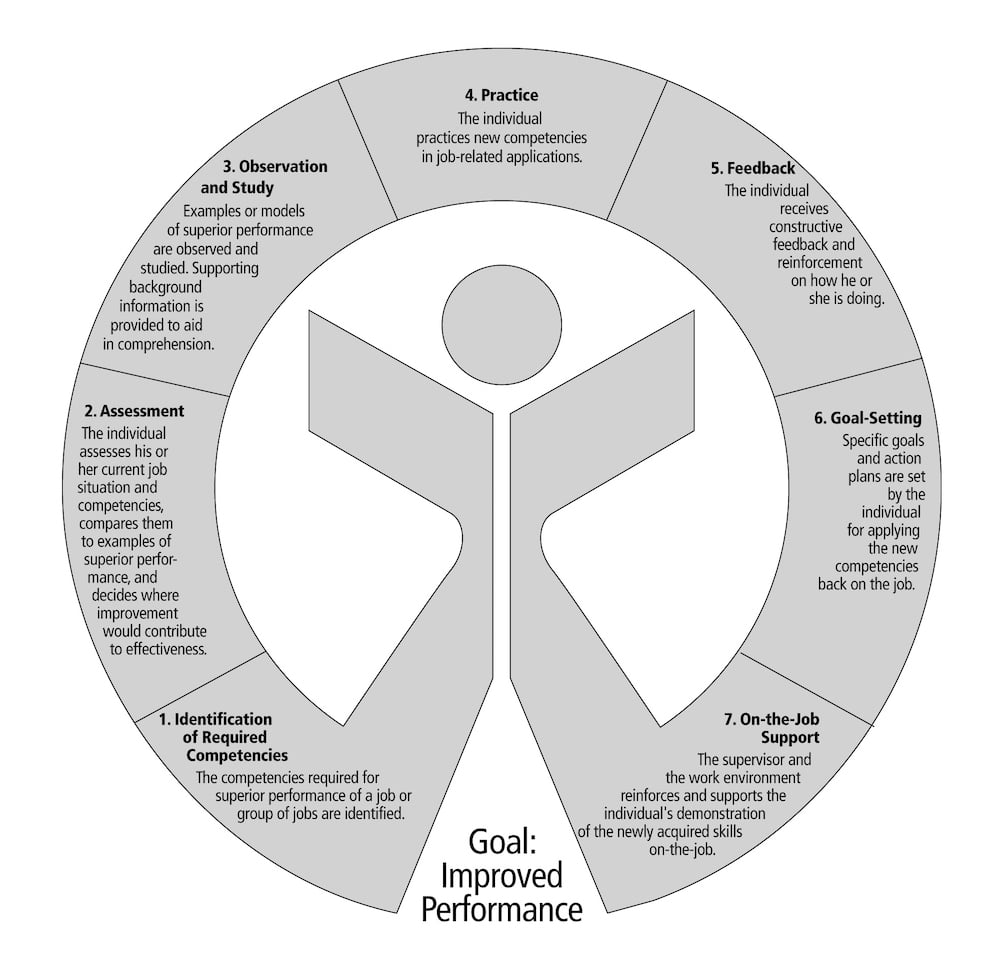In most cases, competencies are probably not acquired through specific training. So, how are competencies acquired? Usually the person is thrust into a situation where it is important to succeed and where success depends on certain skills and behaviors. In this kind of situation, the person may try to imitate available role models, and may also try out various new behaviors. If the behaviors are successful, they become habits or skills.
In this natural acquisition process, not everyone succeeds. For those who do, their success is derived from a combination of situational pressure, willingness to try new behaviors, and specific aptitudes.
To supplement this natural acquisition process, there is another process by which we can develop competencies, and that is as a component of a professional development program. This process has seven steps (illustrated in Exhibit G): (1) identification of the required competencies, (2) self-assessment, (3) observation and study, (4) practice, (5) feedback, (6) goal-setting, and (7) on-the-job support.
1. IDENTIFICATION OF REQUIRED COMPETENCIES
Either through a job competency model or another means, you need to understand each competency well enough to recognize it in your behavior and others’ behavior. Studying the behavioral indicators listed under each competency will help you accomplish this step. You must also be able to apply the competency to yourself, to know when you had the opportunity to do so, but did not do so. To develop your understanding of a competency, think about how you can use the competency and its behaviors in your work. In which specific situations did you use the competency, and in which situations did you miss an opportunity to use it?
2. ASSESSMENT
This step requires that you recognize and have an accurate perception of how often and how well you demonstrate the competency. This is often a difficult step, because many people overestimate their strengths. Research has shown that two-thirds of all employees see themselves in the top third, in terms of overall performance. To assess yourself accurately, you need honest feedback from others who can observe how you work. 360 feedback is a good method for this. Assessment centers or “compare-and-contrast” simulations can also stimulate recognition of a competency that can be developed. (Tips on how to do this are provided throughout Workitect’s Competency Development Guide and in this Assessing Competencies blog post)
3. OBSERVATION AND STUDY
Accompanied by the other six steps, observing others demonstrate a competency will help many people develop a competency. The way in which you learn, i.e. your “learning style”, will determine whether you will more effectively develop a competency by studying the competency or observing other people modeling it, and then practicing it. Many people will rely on the next step.
4. PRACTICE
Try out new behaviors and skills in a relatively “safe” environment, such as a training course or an activity outside work, where you can make mistakes and try to develop your skill. (Part II of the Competency Development Guide contains suggested practice opportunities for each of the 35 generic competencies.)
5. FEEDBACK
This step involves receiving constructive information that conveys the extent to which your “new” behavior is observed and found to be effective. The feedback from others that contributes to the accurate Self-Assessment step is also important to knowing whether the development or strengthening of a competency is occurring. If you don’t know how you are doing, you won’t be able to modify your behavior to ensure that the competency is learned.
6. GOAL-SETTING
You should established a specific goal and timetable to acquire a competency. Goal setting involves identifying specific, measurable action steps and committing these to writing, with dates for theiraccomplishment. A good goal is:
– Specific
– Measurable
– Time-bound
– Realistic
– Challenging, but achievable
7. ON-THE-JOB SUPPORT
When you demonstrate the competency back on the job, you should be made aware that “it matters”. This support and reinforcement can be formal or informal, subtle or not subtle, immediate or long-term. It can be a pat on the back or satisfying appraisal discussion. It is another form of feedback and is essential to maintaining the new behaviors of a competency.
RESOURCES FOR DEVELOPMENT
Types of Development Activities
Providers and Directories of Training and Development Programs
Focused Competency Development Program
Reference: Competence At Work, Lyle & Signe Spencer
_______________________________________________________________________________________
For additional information, please contact us at 800-870-9490 or edward.cripe@workitect.com
Workitect is the leading developer of job competency models and competency-based human resource applications, tools, and programs.




Leave A Comment